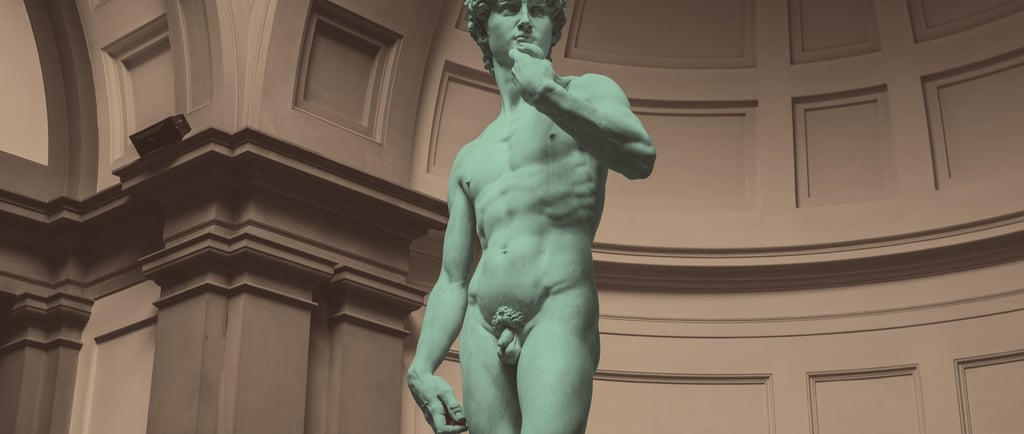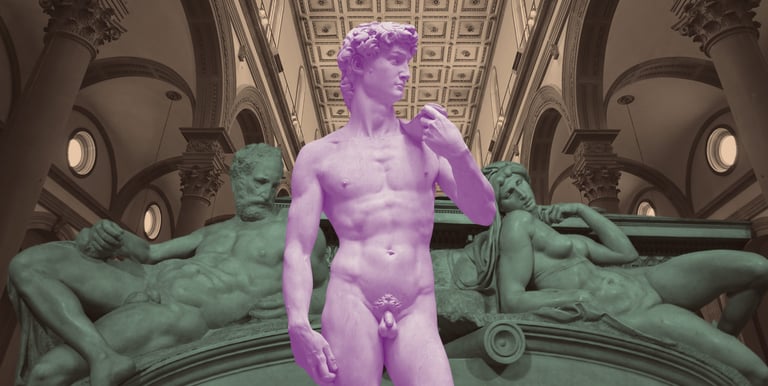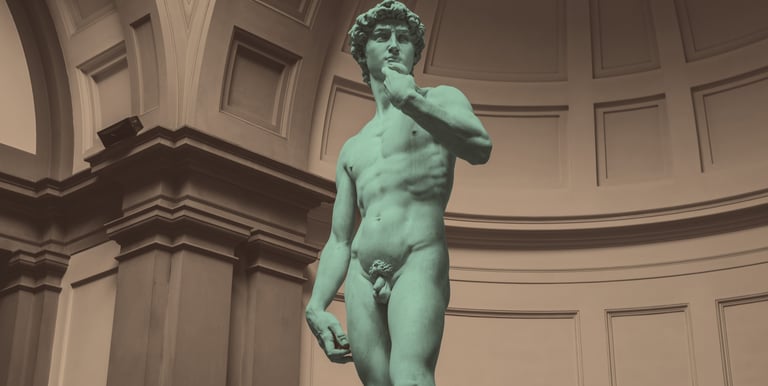The Statue of David: Secrets Behind Michelangelo’s Renaissance Giant
The statue of David by Michelangelo is one of the most iconic masterpieces in Western art—an embodiment of Renaissance ideals, humanist beauty, and civic symbolism. But behind this marble giant lies a story of political upheaval, artistic rivalry, and remarkable engineering. Let’s dive into the hidden history and fascinating details that make the statue of David far more than just a famous sculpture.
Karolina K.
5/28/20254 min read


From Abandoned Block to Renaissance Marvel
What if we told you that the statue of David almost never existed?
The colossal block of marble that became David was originally quarried in Carrara in the early 15th century. Known as il Gigante (“the Giant”), the block stood over 17 feet tall and weighed several tons. Yet it sat untouched for nearly 40 years in the courtyard of Florence Cathedral, considered too flawed to work with.
Two sculptors—Agostino di Duccio and Antonio Rossellino—had already abandoned the project, calling the marble misshapen and "badly rough-hewn." Then, in 1501, a 26-year-old Michelangelo took on the challenge. He promised to carve a complete statue from the single piece of damaged stone—no additions, no do-overs. That bold decision set the stage for a masterpiece.
David as a Symbol of the Florentine Republic
Commissioned by the Republic of Florence after the fall of the Medici family, the statue of David was never just about biblical heroism. David—the underdog who defeated Goliath—became a political metaphor for Florence itself: small, but cunning and powerful enough to stand up to tyrants.
Originally intended to be placed high on a cathedral buttress, the completed statue was ultimately installed in front of the Palazzo Vecchio, Florence’s town hall. There, on Piazza della Signoria, David stood not just as a work of art, but as a guardian of the city’s republican ideals.
Anatomical Genius and Artistic Illusions
Standing 17 feet tall (5.16 meters), the statue of David is both idealized and subtly imperfect. Michelangelo used anatomical exaggeration to enhance its impact when viewed from below. David’s head and hands are intentionally larger—symbols of intelligence and strength—and his gaze is fierce and focused.
Even more intriguingly, modern researchers have found that David’s eyes are not aligned. This rare condition, called exodeviation, was likely intentional. From ground level, the misalignment disappears, creating the illusion that both eyes are locked on an invisible enemy.
The Moment Before the Battle
Unlike earlier depictions (such as Donatello’s youthful David after the battle), Michelangelo chose a moment of tension—David’s body is coiled, muscles engaged, his sling slung over one shoulder and a stone clenched in his right hand. This isn’t triumph; it’s anticipation.
That choice says everything about the Renaissance spirit: a celebration of human potential, courage, and reason. David wins not through brute force, but through intellect and precision.
A Target of Both Praise and Violence
Unveiled publicly in 1504, the statue of David was immediately hailed as a triumph. Giorgio Vasari, the great art historian, called it the most perfect sculpture—surpassing even the works of ancient Greece and Rome.
But not everyone admired it. During its transport to the piazza, Medici loyalists threw stones at the statue. In 1527, David's left arm was broken during civil unrest. Over the centuries, it has been moved, protected, and restored, now housed safely in the Galleria dell'Accademia.
Why the Statue of David Still Matters
More than five centuries after its completion, the statue of David continues to inspire and provoke. It represents the pinnacle of artistic skill, the complexity of political symbolism, and the timeless power of human expression.
Whether you see it in person in Florence or in photographs and replicas around the world, remember: the statue of David is not just a sculpture. It's a revolution in marble—a reminder that even flawed beginnings can lead to greatness.
Keywords: statue of David, Michelangelo David, David sculpture, Renaissance art, Florence statue, Michelangelo masterpiece, Galleria dell’Accademia
Check our tours
Find out more about Michelangelo's David from our art expert guide on private tour in Florence
Florence: Michelangelo Masterpieces Private Guided Tour & Tickets
Follow in the footsteps of Michelangelo on this expert-led tour through Florence’s Renaissance treasures. Marvel at David and the Prisoners at the Galleria dell’Accademia, admire the bold architecture of the Laurentian Medici Library, and explore the Medici Chapels, where Michelangelo’s sculptures echo with power, beauty, and contemplation.
Key Benefits:
Skip-the-line access to Galleria dell’Accademia di Firenze & Museo delle Cappelle Medicee
Expert local guide with deep knowledge of Michelangelo’s life and work
Small-group & private format for a more personal experience
A complete narrative of Michelangelo’s artistic and architectural legacy in Florence
🎫 Includes tickets to Galleria dell’Accademia di Firenze & Museo delle Cappelle Medicee
3 hours. 3 monumental sites. 1 unforgettable journey into the mind of a genius.
Florence: Accademia Gallery & David Private Guided Tour
Step into the heart of Florence and experience the Galleria dell’Accademia like never before—with your expert guide.
Our private tours are designed for travelers who want more than just a photo of David. We bring the art to life with vivid storytelling, insider insights, and rare details you’d never discover on your own.
Key Benefits:
Skip-the-line access – No waiting, no hassle
Expert private guide – Tailored to your interests, no crowds
Deeper understanding – Learn the secrets behind David, the Prisoners, and Renaissance masterpieces
Unforgettable experience – Walk away with stories that stay with you
🎫 Includes Galleria dell’Accademia entry tickets
Whether it’s your first time or your fifth, this is how Michelangelo was meant to be seen.
Contact
Contact us via email:
Subscribe to our newsletter!
office@tellmemoretravel.com
© 2025. All rights reserved.




